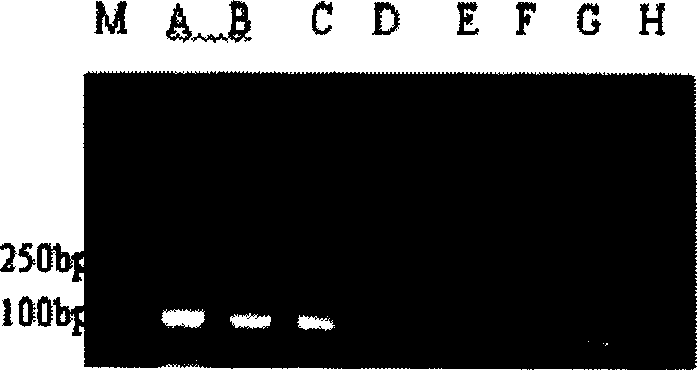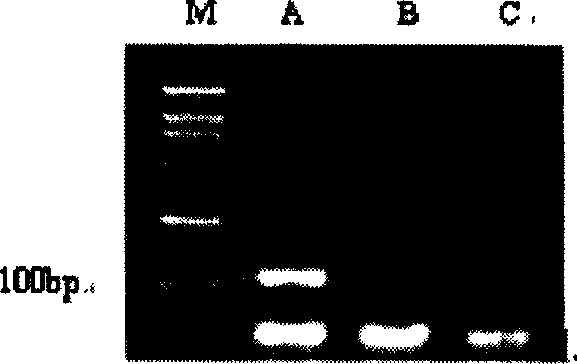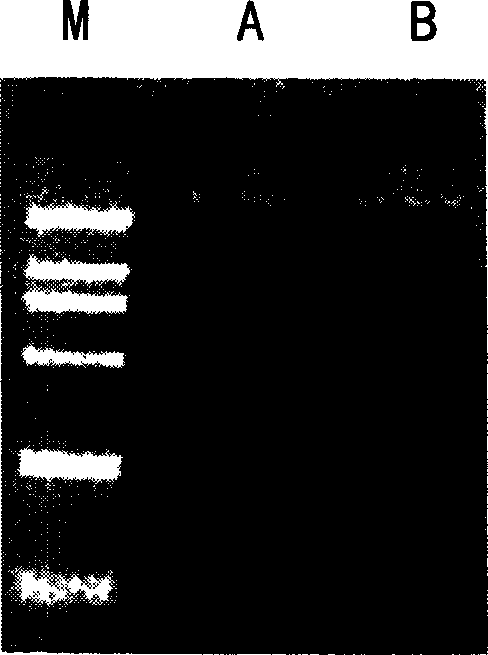Primer and TaqMan probe for qualitative and quantitative detection of blue tongue virus
A technology for quantitative detection of bluetongue virus, applied in the direction of microbial determination/inspection, biochemical equipment and methods, etc., can solve the problem of real-time fluorescent quantitative PCR detection technology without bluetongue virus gene, without primers and specific fluorescent probes And other issues
- Summary
- Abstract
- Description
- Claims
- Application Information
AI Technical Summary
Problems solved by technology
Method used
Image
Examples
Embodiment 1
[0033] Embodiment 1, be used for bluetongue virus (BTV) carrying out the design of the primer of qualitative, quantitative detection and TaqMan probe
[0034] According to the NS1 gene sequences of 8 serotypes of BTV in GenBank, DNAStar software was used to compare the sequences of the NS1 genes of the 8 serotypes of BTV, and the most conserved region sequence at the 5' end of the NS1 gene was selected as the detection sequence. Since there are 6 serotype BTV NS1 gene sequences (GenBankAccession No.AY462225, M97762, NC_006025, X15891, X56735, Y00422) in the 8 serotype BTV NS1 genes including a longer 5' non-coding region sequence, DNAStar software was used to analyze The 6 serotypes / strain BTV NS1 gene sequences were compared, and then primers and TaqMan probes were designed according to the comparison results. The sequences are as follows:
[0035] Upstream primer P (NS1-1): 5'-GTTTCTAGTTGGCAACCACC-3' (SEQ ID NO: 1 in the sequence listing), Tm is 57°C;
[0036] Downstream pr...
Embodiment 2
[0043] Embodiment 2, carry out the conventional PCR detection of BTV to bluetongue virus with primers of the present invention
[0044] 1. Processing of BTV samples
[0045] Eight BTV serotypes (BTV3, BTV5, BTV8, BTV10, BTV11, BTV21, BTV22, BTV(A)) in cell cultured BTV, plasma and tissue were selected as BTV samples to be tested.
[0046] The cell-cultured BTV samples were processed by the following method: first inoculate BTV to BHK-21 cells, and inoculate at 37°C CO 2 Cultivate in an incubator until the pathological changes of the cells reach more than 80%, then transfer the diseased cells into a sterilized centrifuge tube under aseptic conditions, centrifuge at 8000rpm for 30min, and transfer the supernatant to another centrifuge tube under aseptic conditions and temporarily place it at room temperature Next, the cell pellet was repeatedly frozen and thawed three times, then the supernatant was added, mixed by pipetting, centrifuged at 8000rpm for 30min, and the supernatan...
Embodiment 3
[0054] Embodiment 3, carry out the real-time fluorescent quantitative PCR (real-timeFQ PCR) detection of BTV with primer of the present invention and TaqMan probe
[0055] 1. Cultivation and treatment of BTV
[0056] Cell-cultured BTV was selected as the BTV sample to be tested, and the same method as in Example 2 was used to treat the cell-cultured BTV sample.
[0057] 2. Extraction of BTV RNA
[0058] Take 300 μl of the BTV sample obtained in step 1, and use the same method as in Example 2 to extract RNA.
[0059] 3. Reverse transcription
[0060] Using the RNA of the BTV sample extracted in step 2 as a template, its cDNA was synthesized by reverse transcription, and the reaction system and reaction conditions were the same as those in Example 2.
[0061] 4. Preparation of real-time FQ PCR standards
[0062] (1) PCR amplification product recovery of BTV-5
[0063] Take 50 μl of the PCR amplification product of the detection sample BTV5 obtained in Example 2, carry out 2...
PUM
 Login to View More
Login to View More Abstract
Description
Claims
Application Information
 Login to View More
Login to View More - R&D
- Intellectual Property
- Life Sciences
- Materials
- Tech Scout
- Unparalleled Data Quality
- Higher Quality Content
- 60% Fewer Hallucinations
Browse by: Latest US Patents, China's latest patents, Technical Efficacy Thesaurus, Application Domain, Technology Topic, Popular Technical Reports.
© 2025 PatSnap. All rights reserved.Legal|Privacy policy|Modern Slavery Act Transparency Statement|Sitemap|About US| Contact US: help@patsnap.com



